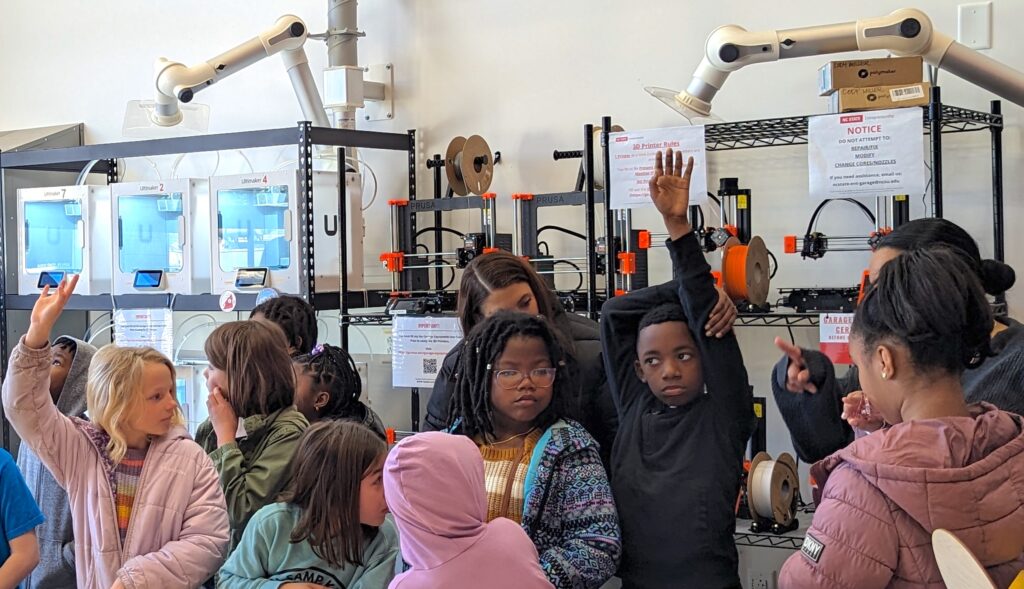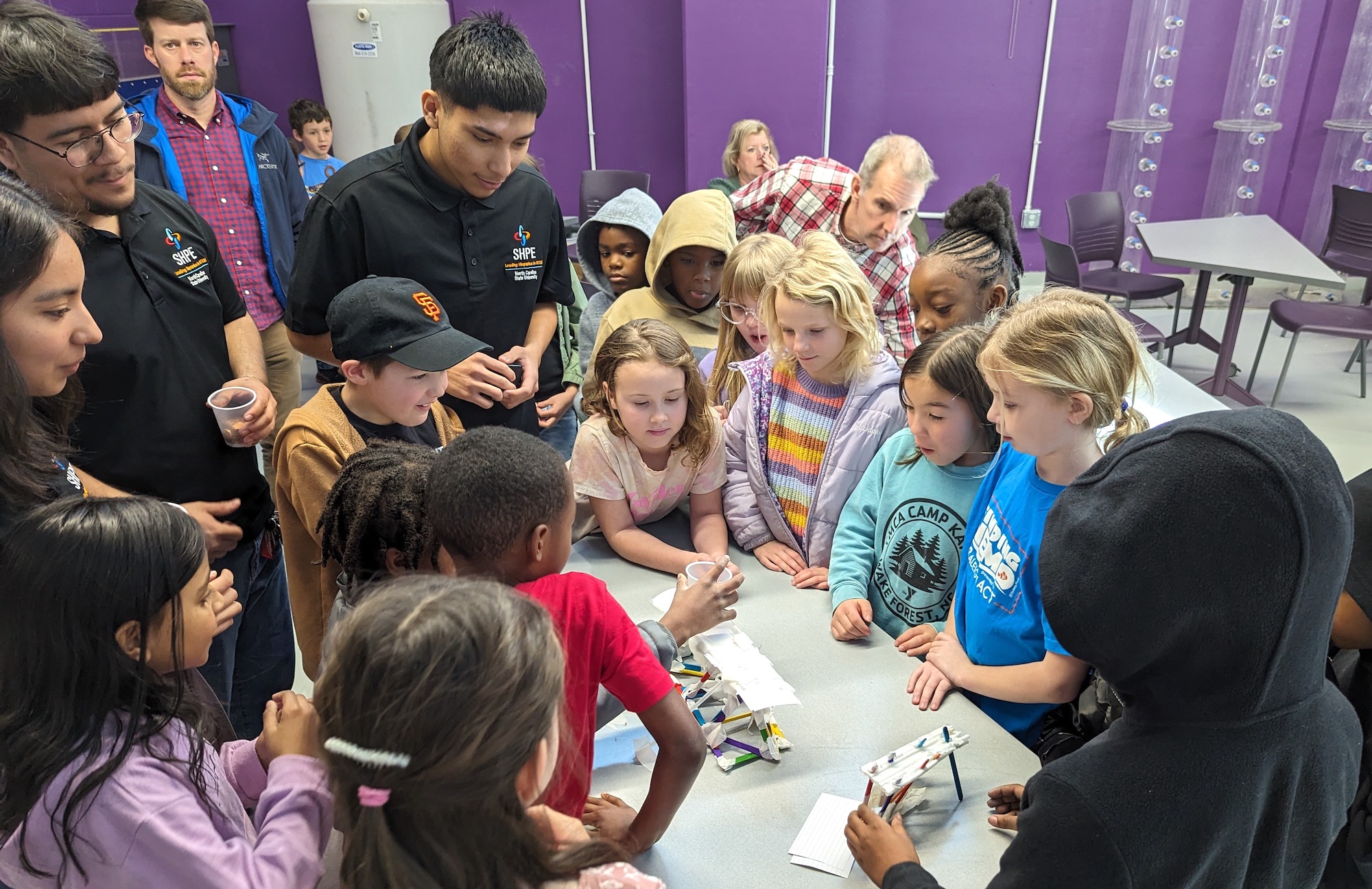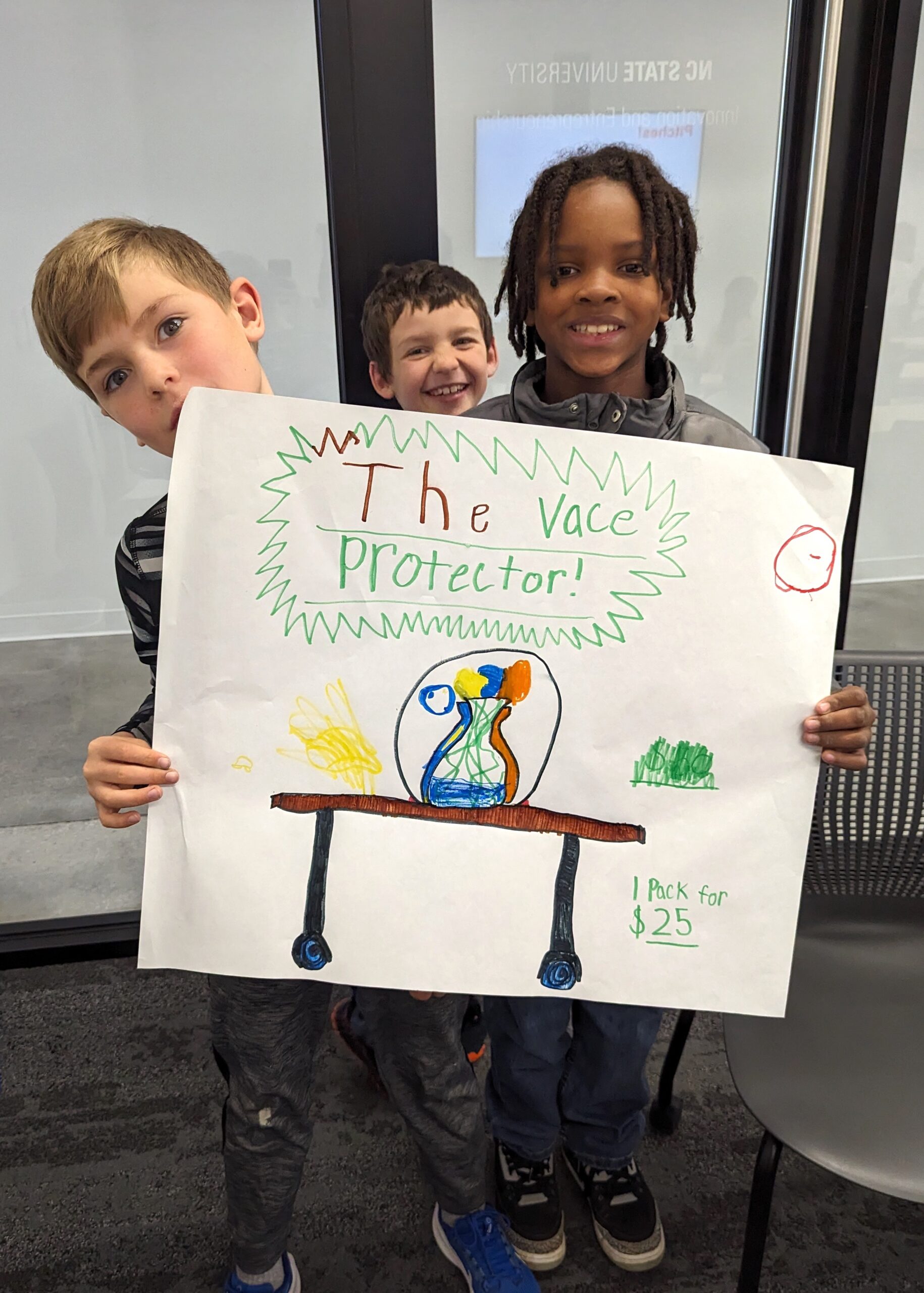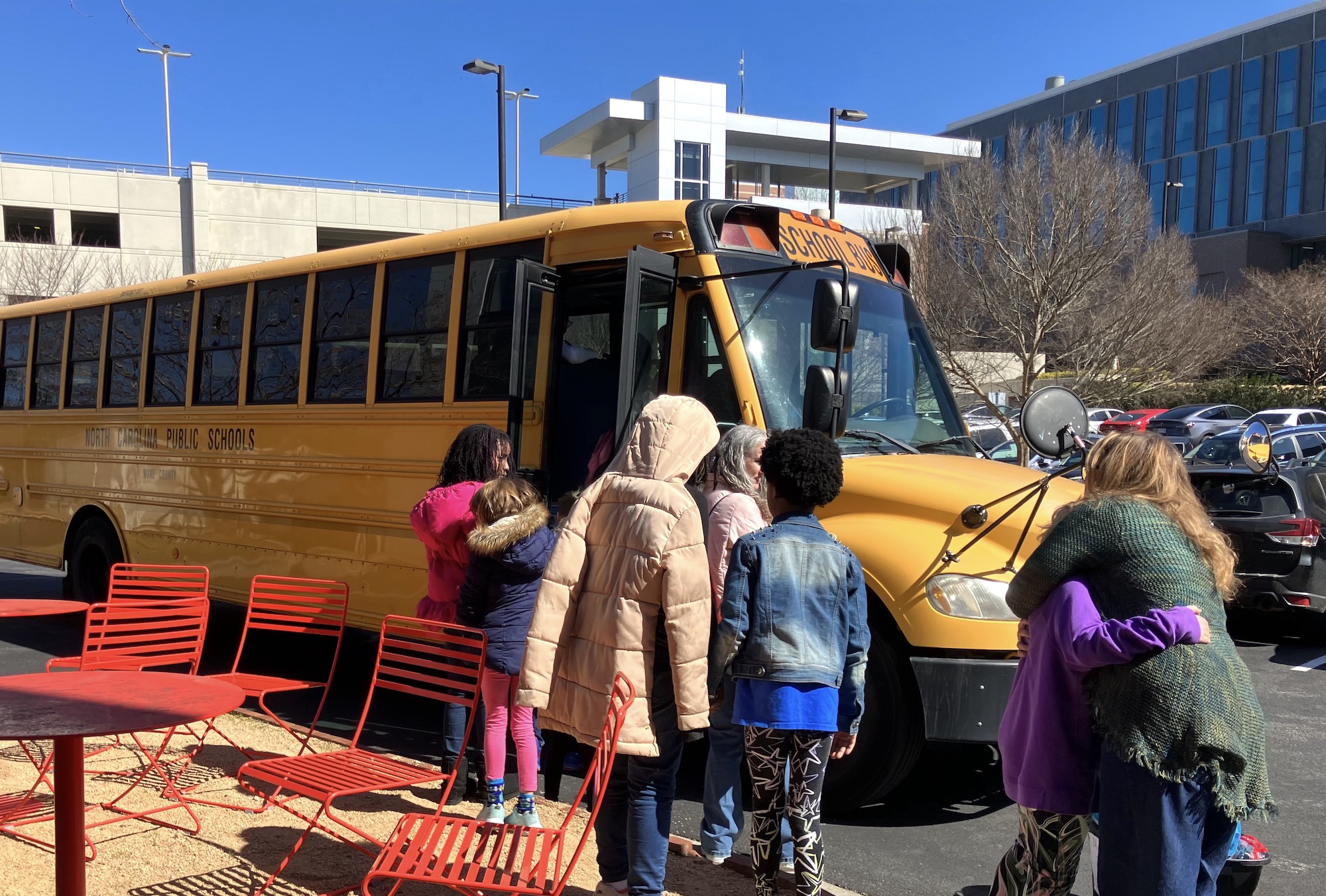What Does an Innovative Field Trip Look Like?

The parents waiting in the co-working space of the Albright Entrepreneurship Garage seem a little unsure about what will happen next, but the room has a happy, excited energy as they mingle. Like several of the others, this is my first time chaperoning a field trip for my fourth grader at Conn Magnet Elementary School of Entrepreneurial Design. In my position as project manager in the Office of Outreach and Engagement, my bread and butter is the faculty, staff and students who work with off-campus community groups in shared research and learning experiences. Today, my professional and personal worlds collide. I get to see a field trip to NC State through the eyes of a nine-year-old.
My job is ensuring all kids have all the opportunities from kindergarten through fifth grade.
Conn Magnet Elementary School of Entrepreneurial Design Magnet Coordinator Daniel Gridley
Soon the two buses arrive, and the teachers who disembark are reassuringly more confident than the parents. They split up the herd and start funneling students into the Garage and across Partners Way to Fitts-Woolard Hall. It feels like Centennial Campus belongs to these fourth graders and their teachers. As I learn later, that is intentional.
At the epicenter of this controlled chaos is Daniel Gridley, magnet coordinator at Conn. Gridley describes his job as “ensuring all kids have all the opportunities.” He collaborates with each grade’s teaching teams to create experiences where they can “apply their learning and understanding” of STEM-based design thinking. The practical effect of providing all the opportunities to all the kids is that it seems like Gridley is everywhere, all the time. Because he works with each grade, he is a presence in our students’ lives throughout their time in elementary school. Today he is in his element.
Society of Hispanic Professional Engineers Builds the Future
My kid is in the group that goes to Fitts-Woolard Hall first, where undergraduates in the Society of Hispanic Professional Engineers (SHPE) lead the children through two engineering activities. After a brief presentation, their first challenge is to build the tallest tower in the room using only pipe cleaners — in five minutes.
It is even more crucial for minority students to see others who look like them in the engineering field.
Society of Hispanic Professional Engineers President Andrea Zamudio
The second activity is to construct a bridge at least six inches high and 12 inches tall using only straws, popsicle sticks, index cards and tape to support the weight of 100 pennies, a delightfully age-appropriate measure of weight. Students from SHPE float around the room lending their expertise, explaining how triangles are strong. The chaperones wander around, too, asking questions, offering encouragement, and fighting the urge to intervene in precarious structures. Mostly the students want to know whose dad I am.

SHPE President Andrea Zamudio explains there is a strong mission behind the pennies and pipe cleaners. It is “crucial for young students to feel as though the engineering design cycle is something that is approachable and applicable to their daily lives, and it is even more crucial for minority students to see others who look like them in the engineering field.” Zamudio says introducing students to STEM should start early. Inviting schools into our NC State labs and classrooms allows “each student to truly see themselves on a college campus even at a young age.”
Gridley agrees. “Exploring the state-of-the-art facilities and witnessing the cutting-edge research being conducted left a lasting impression on their young minds.” It is this lasting impression that Gridley points to as his measure of success for trips like this: Do the students talk about it later? Do they bring up what they experienced during future projects? What experiences lay the foundation for a young child to become a future member of SHPE? Zamudio explains more about the values that drive their outreach work in this podcast from Conn.
How to Design an Entrepreneurial School of Design
As noted by Gridley, these hands-on experiences “not only deepened their understanding of engineering principles but also used our IDEAS Design Cycle,” a problem-solving framework taught in all grades at Conn (K-2 students get their entrepreneurial field trip fix at Marbles Kids Museum). IDEAS is an acronym that lays out the process of entrepreneurial design: Identify a problem they care about. Develop a plan, Execute the plan. Assess the plan. Share the plan and what was learned. The teachers distribute laminated, writable one-pagers about the IDEAS Design Cycle to each of the small groups. They children take in the instructions for their mini construction projects.
This field trip to NC State is only one facet of a robust STEM and entrepreneurship program that helped earn Conn the Top School of Excellence Award by the Magnet Schools of America (MSA), its third year in a row to win an MSA National Merit Award. According to Gridley, Conn is one of only seven entrepreneurship-focused elementary schools in the country. That means there is not an abundance of ready-made curricula and learning materials for their educators to choose from.
Nevertheless, Conn went from starting from scratch to award-winning in only a few short years. They chose their most recent magnet school theme in 2016. In 2019, the whole school moved to the Wake County Public School System temporary campus so their aging building could be torn down and replaced with a bigger school. The global COVID-19 pandemic struck before they could move back in, however, and my son completed kindergarten online. Gridley says last school year was the first time they had major field trips again.
Teachers instill the entrepreneurial design mindset from kindergarten, providing students with continuous opportunities to engage in group project-based learning experiences. As they progress through each grade, students work collaboratively in teams to hone their critical thinking skills. A field trip like this is a unique opportunity to extend the curriculum into Conn’s community, which now includes the network of engaged scholars at NC State who helped make this field trip possible.
Solving #KidLife Problems at the Albright Entrepreneurship Garage

After an hour of furious construction, our half of the group walks back to Partners Building I, home of the Albright Entrepreneurship Garage. The space is a “venture creation and prototyping space designed for student entrepreneurs.” As a department, NC State Innovation and Entrepreneurship hosts roughly 30 visits per academic year from K-12 schools. In one year, that works out to about 650 students, 60 instructors and 100 family chaperones.
What are the learning objectives when schools visit the Garage? “The first thing that’s important for the students is to expand their horizons on what is possible. To see what kind of alumni businesses have rocketed to success from the University and that maybe they can make something some day!” says Kenneth Proseus, events & operations manager with Innovation and Entrepreneurship. This is accomplished by a presentation highlighting entrepreneurial alumni like Leigh-Kathryn Bonner, founder of Bee Downtown. Bonner, Proseus explains to the students, figured out a way to increase urban bee density by reframing beekeeping as an ongoing team-building activity for organizations.
In a spacious classroom at the Garage, Proseus puts the students into groups. They are asked to invent a product that solves a problem and pitch it to the class. They enthusiastically start to unpack and debate the many woes of fourth-grade life. The final pitches earn approving sounds from the students in the audience. Products include a computer that lets you use it even when your parents say no, a faster pencil sharpener, a clear plastic bubble to prevent vases from breaking when knocked over, a traffic control system for crowded Conn hallways and — my favorite — a small, portable, touch-free vortex for getting Cheetos dust off your fingers.
The first thing that’s important for the students is to expand their horizons on what is possible.
Innovation and Entrepreneurship Events & Operations Manager Kenneth Proseus
Individual passions shine through and are reflected in each group’s product design and pitch: one student highlights a mechanical, single pole, double throw switch at the center of the hallway traffic system. A girl dives deep on the user interface elements of a vending machine that requires you to order something healthy before getting a snack.
Little Thinkers, Big Ideas
Throughout their six years at Conn Magnet, students benefit from numerous connections, engagements and developmental events, thanks to the school’s robust community partnerships. It’s clear that developing these community connections is always top of mind for Gridley. He is quick to bring up the opportunity to keep working with the children. Big Idea Week is coming up in April, he says, and they can always use some community volunteers to help judge the student competition or share their entrepreneurial pathway.

Suddenly it’s noon and Proseus shouts his last goodbyes to the students as they bustle out of the room. The chaperones hug their kids and some other kids, too. The students are counted and filed back onto the yellow buses. The parents’ nervousness is gone and only smiles remain. I don’t know if I was particularly useful as a chaperone, but I am basking in the glow of a job well done: the job done by these educators from Conn and NC State to collaboratively create an entrepreneurship and STEM-filled field trip to a university campus. The first for many of the students but not the last, if these educators have anything to say about it. Happily, they do.